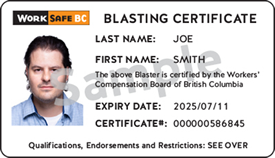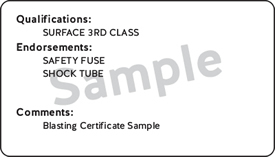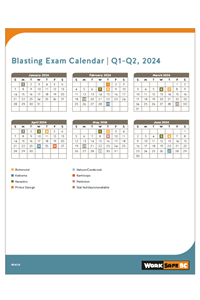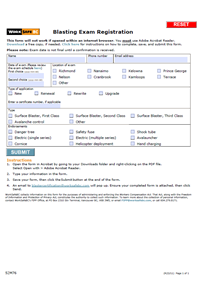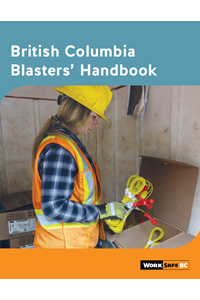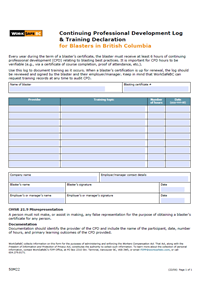Blaster certification
Register for all blasting exams, now being held in person
Registration for any type of blasting exam is open, and details can be found in the Registration process section, below.
In B.C., anyone working as a blaster must be certified. Any blasting work performed must be within the scope of the qualifications and endorsements of the certificate. WorkSafeBC is the regulator for blasting activities such as construction, tunnelling, demolition and avalanche control. To become certified by WorkSafeBC, blasters must provide documentation supporting their practical competency, and pass a written exam.
For general blasting examination questions, or to ask about examination accommodations, please contact Blaster Certification Services at blastercertification@worksafebc.com.
Phone: 604.276.3090, or
Toll-free: 1.888.621.7233 local 3090
Blasting certificates must be valid and up-to-date. Those issued by WorkSafeBC expire on the date indicated on the certificate. Certificates issued in another jurisdiction may be eligible for WorkSafeBC out-of-jurisdiction blaster certification. Initial/new blasting certifications are issued for a period of two years.
A blaster whose certification has expired must write and pass another blasting exam to be recertified. Renewal blasting certifications and out-of-jurisdiction blasting certifications are issued for a period of up to five years.
All blasting certifications may be endorsed with any restriction that WorkSafeBC deems necessary. See Qualifications and endorsements, for more information.
To become certified, blasters in B.C. must provide documents supporting their eligibility, practical competency, and pass a written exam. WorkSafeBC blasting exams are taken in person. Space is limited so we advise that blasters register early.
You’ll find the WorkSafeBC Blasting Exam Package helpful for new blasters or those renewing their certification. It includes a checklist of documentation requirements and provides guidance for the documents we require with your registration. It’s important to note that missing documents will prevent you from participating in the exam. Please make sure you carefully read the Blasting Exam Package, and have all the required documents.
Step 1: View the Blasting Exam Calendar and choose your preferred date and location.
Step 2: Complete the Blasting Exam Registration to communicate your exam preferences — type of exam, preferred date, and location — and submit it to us in Certification Services.
Step 3: Pay exam fees
We’ll send you a link where you can prepay for your exam by credit card. Once you have completed the transaction, we’ll await confirmation of payment. Please note this may take 1–2 business days.
Step 4: Scheduling confirmation
When payment has been confirmed, we’ll send your exam details to you for the time and location of the exam. Space is limited so please register early.
To write a blasting exam, applicants are required to provide the following documents:
- Blasting Log Books (specifications provided in registration package)
- Blasting Certificate if holding
- Natural Resources Canada Explosives Regulatory Division (ERD)1 Approval Letter, PAL, Permis General, Nexus or Fast Card
Initial certification or upgrades
Additional documents (written proof) are required for initial certification or upgrades:
- Employer Letter2 specifying employer training to competency of certification class and endorsement sought
- Training declaration (form provided in the registration package)
Download and review WorkSafeBC's Blasting Exam Package (registration information) for more detailed information on each requirement.
Proof of knowledge, qualifications, and experience
Written proof as required by section 21.8(a)(c) must include a description of the candidate's experience and must clearly indicate the following:
- Training provided to the candidate
- Minimum of 8 hours of training relating to safe handling of explosives
- Type of blasting methods a candidate has observed and participated in
- Type of explosives used
- Locations of blasting experience
- Name(s) of certified blaster(s) overseeing the training, including certificate numbers
- Length of time (including dates) the candidate worked with the certified blaster(s)
The blaster(s) providing training to a candidate should:
- Have a minimum of 2 years' experience within the same class qualification
- Have no certificate suspensions within the past 2 years
- Be competent and knowledgeable in the endorsements held
The written proof must clearly indicate the candidate has at least six months practical experience in a blasting operation, or as an assistant to the blaster, and is competent and knowledgeable in the handling and use of explosive materials.
Notes:
- The information on obtaining an ERD Approval letter can be found at the following link: https://www.nrcan.gc.ca/explosives/resources/guidelines/13963
- The employer letter must outline and attest to the candidate’s experience and competency in conducting blasting operations under the Occupational Health and Safety Regulation (OHSR) Part 21. See more details and letter requirements in WorkSafeBC's Blasting Exam Package.
Download and review WorkSafeBC's Blasting Exam package (registration information) for more detailed information.
Blasters from outside B.C.
Please complete and submit the following, to register for an out-of-jurisdiction interview with an examiner:
- Application for WorkSafeBC Blasting Certificate
- WorkSafeBC Out-of-Jurisdiction Blasting Registration Package
- Jurisprudence package for other jurisdictions: A self-directed study guide for blasters from other Canadian jurisdictions to obtain blasting certification in British Columbia.
To prepare for the WorkSafeBC blasting exam, candidates must be familiar with the information contained within the following resources:
- Part 21 of the Occupational Health and Safety (OHS) Regulation
- WorkSafeBC's Blasters' Handbook
- Transportation of Dangerous Goods Regulations
- Explosives Act and Regulations
Every year during the term of a blaster’s certificate, the blaster must receive at least 6 hours of continuing professional development (CPD) relating to blasting best practices. It is important for CPD hours to be verifiable (e.g., via a certificate of course completion, proof of attendance). The following resources will help you complete this requirement:
- Continuing Professional Development Log & Training Declaration: Blasters can use this form to track important training details and have them verified by the employer when the blaster’s certification is up for renewal.
- Continuing Professional Development Topics — Blasters: A broad range of topics are suitable for CPD. This information sheet provides some that are considered relevant to blasting best practices.
If you have questions about whether a topic may qualify for CPD, please contact Certification@worksafebc.com.
A blasting certificate is only eligible for an extension if it has not expired. To be granted an extension, the blaster will have paid for and scheduled the next available exam date.
When a certificate expires before the next available exam date, a certification officer may issue a provisional certificate that will be set to expire the day before the blaster's scheduled exam date.
The Occupational Health and Safety Regulation requires the Blaster of Record to maintain pre- and post-blast loading details and results in a blasting log. Logs are to be kept for at least five years. These blast logs must be maintained at the worksite and be available for an inspection by officers, workers, and worker representatives.
These fillable templates provide you with the option to print the completed form, save it to your device, or click the submit button to email a copy to someone else. View and download the appropriate log, as follows:
- Urban and Construction (First and Second Class) Blasting Log
- Forestry (Third class) Blasting Log
- Avalanche Control Blasting Log
The following table outlines WorkSafeBC’s Blasting re-examination waiting periods for applicants who are rewriting full exams, endorsement portions only, or upgrades to existing certificates. Re-examination is based on availability after the elapsed wait time.
| Blasting Re-exam | Re-exam Wait Time |
| 2nd Attempt | 48 hrs. |
| 3rd Attempt | 30 days |
| 4th and Subsequent Attempts | 90 days |
Cost of certification
For renewing or initial blasting certificate: $120
Rewrite, upgrade, or removing a restriction: $70
These costs include exam fees and upon success, a hardcopy certificate with the blaster's name, photo ID, and qualifications. (See Blasting certification card samples in the next section).
Replacement cards
A certified blaster who has lost or damaged their blasting certificate may request a replacement certificate. The replacement certificate will expire on the same date the original certificate would have expired. A provisional certificate may be issued by a certification officer to bridge the time required for the replacement certificate to be issued and forwarded to the blaster.
Replacement cards will be issued to valid certificate holders for ($25 + tax = $28)
Cancellation policy
- If the candidate cancels their scheduled exam seven (7) days in advance, the fee will be applied to a future exam.
- If the candidate cancels their scheduled exam 6 days or less before the exam date, no refund will be issued and the candidate must pay the registration fee again to register for a future exam.
- If Certification Services cancels the exam at any time, the fee will be applied to a future exam OR a full refund will be provided.
Front
A photo of the certificate holder appears on the front of the certification card.
Back
The back of the certification card includes three sections: qualifications, endorsements, and comments. Restrictions will be placed in the comments section on the back of the certificate.
Certificate endorsements and/or restrictions will be based on the nature of the work performed by the applicant, and the applicant’s experience.
The blasting examiner chooses what appears in the three sections shown on the reverse side of the blasting certificate. This determines the scope of work allowed by the holder of the certificate.
- Qualifications — Only one qualification will appear in this field, from the "Blasting qualifications/Type" column.
- Endorsements — Up to four different endorsements can appear here. The content comes from the "Initiation systems" or "Endorsements" columns.
- Comments — Any additional qualifications, endorsements, restrictions, or other comments can be added here. This content can come from any of the three columns, or a blasting examiner's notes/comments.
The Qualifications and Endorsements sections always include text. The Comments section may be filled out or left blank.
The following shows the list of qualifications and endorsement currently used in BC:
Blasting qualifications/Type
- Avalanche control
- Surface Blaster 1st Class
- Surface Blaster 2nd Class
- Surface Blaster 3rd Class
- Danger tree
- Seismic
- Underground
- Demolition
- Other (propellants, law enforcement/metal hardening/explosive joining/EOD/as specified)
Initiation systems
- Safety fuse
- Shock tube
- Electric (single series or multiple series)
- Electronic (manufacturer-specific)
- Unrestricted
Endorsements
- Hand charging
- Cornice
- Avalauncher
- Helicopter deployment
- Other (powerline/pipeline/as specified)
Energy Safety Canada issued Oilwell Perforators Safety Training and Seismic Blaster Safety Training Certificates are recognized by WorkSafeBC.
WorkSafeBC also recognizes blasting certificates issued in other Canadian jurisdictions. Blasters with out-of-jurisdiction certificates can be issued a WorkSafeBC blasting certificate if they meet the following criteria:
- Certificates must be valid and up to date. Certificates issued by WorkSafeBC will expire on the same date as the out-of-jurisdiction certificate or 5 years, whichever occurs first. Certificates with no expiry date are acceptable; however, certificates issued by WorkSafeBC will only be valid for up to five years and may be endorsed with any restriction that WorkSafeBC deems necessary.
- The out-of-jurisdiction blasting certificate must have been required by a Canadian government body or regulatory authority or issued by a training and certification provider recognized by the Canadian government body or regulatory authority in the issuing jurisdiction.
- The out-of-jurisdiction blasting certificate is required in order to perform blasting operations in the issuing province or territory.
- The scope of activities covered by the out-of-jurisdiction blasting certificate are similar to the blasting codes recognized by WorkSafeBC's blasting certification scheme.
For information about blasting specific to the oil and gas industry, see Oilwell Perforators Safety Training and Seismic Blaster Safety Training.
To find out how to obtain your blasting certificate in B.C., please contact blastercertification@worksafebc.com for more information.
To obtain an avalanche control blasting certificate, you must have a minimum of 6 months blasting experience working under another blaster of record along with 6 missions and 25 shots in for each endorsement sought (exclusive of Cornice Control — see below for cornice blasting endorsement requirements). Only 2 missions per day can be included as part of this prerequisite.
Each avalanche control blasting ticket will be issued for use with safety fuse initiation unless otherwise specified. There are currently 4 endorsements that may be sought:
- Hand Charging
- Cornice
- Helicopter Deployment
- Avalauncher
Hand Charging — An avalanche control technique where personnel on the ground throw or place explosives into the avalanche path start zone. Often performed while wearing skis. Also includes case charging, tram charging and rope charges for cornice.
Cornice Control — An avalanche control technique where personnel on the ground use mountain rope access techniques to place charges and/or detonate several charges at once with detonating cord.
New cornice blasting endorsement requirements are as follows:
- Prerequisite of Hand Charging OR Helicopter Deployment endorsements
- Minimum of 6 missions of Cornice Control under the supervision of a blaster with this endorsement
- No minimum number or quantity of shots required
Helicopter Deployment — The dropping of explosives from a helicopter to perform avalanche control.
Avalauncher — A nitrogen-powered launcher designed for delivery of explosive rounds to the intended target.
See Certification requirements and Registration process for more information on how to acquire a WorkSafeBC avalanche control blasting certificate.
For information on when avalanche control blasting courses are offered, please contact the Canadian Avalanche Association, or check the CAA's course calendar.
Other jurisdictions in B.C. also issue blasting certificates:
- For information on certification for mining operations, contact the Ministry of Energy, Mines and Low Carbon Innovation.
- For information on licensing in pyrotechnics or fireworks, contact Natural Resources Canada at 613.948.5200.
Highlights
- Newly revised British Columbia Blasters’ Handbook now available Published on: March 31, 2023
- Amendments to Occupational Health and Safety Regulation in effect December 1, 2021 Published on: December 01, 2021

